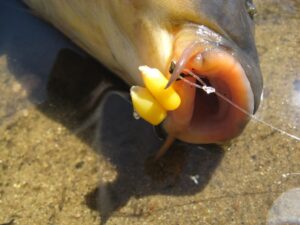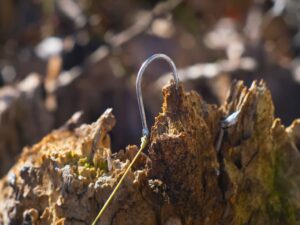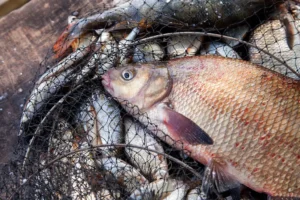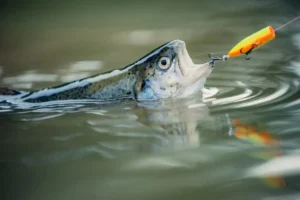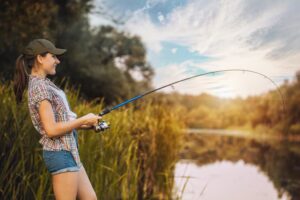Essential Guide to Trout Fly Fishing
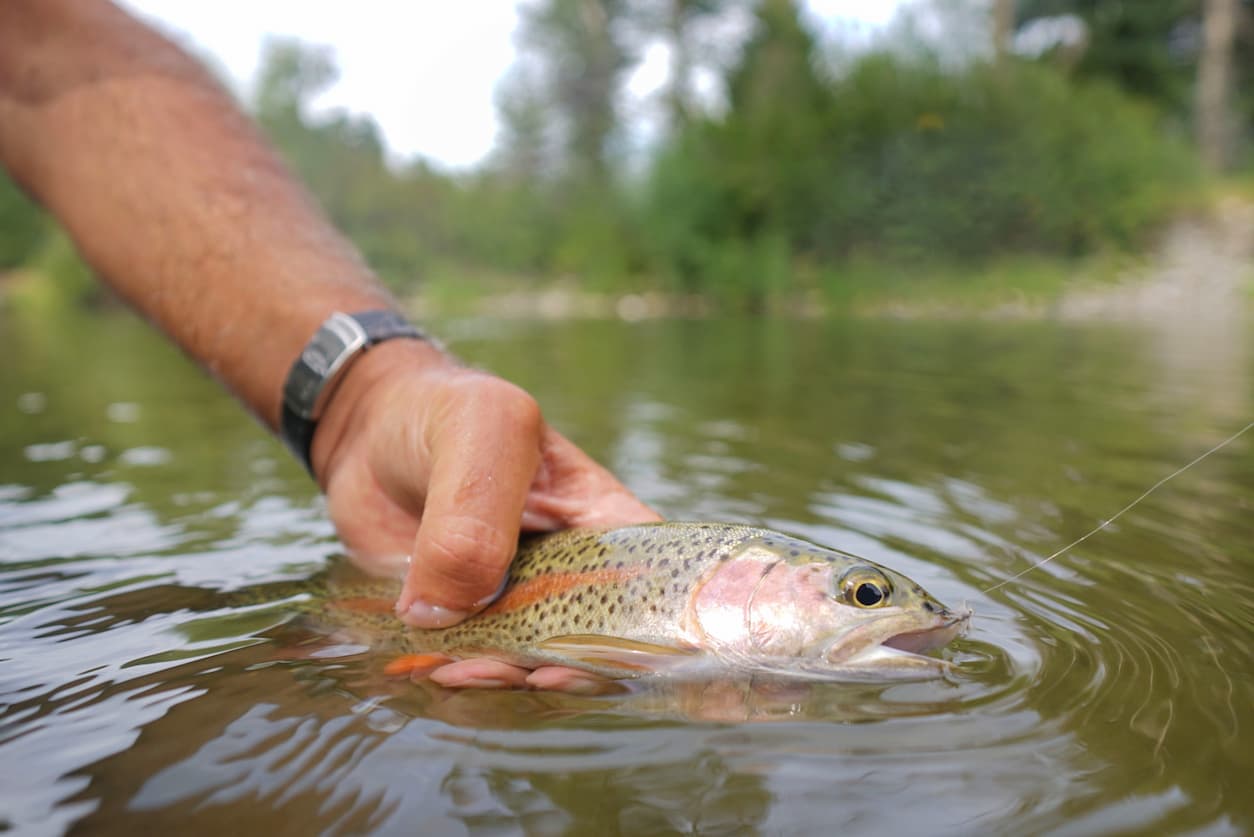
Whether you’re a beginner or an advanced angler, trout fly fishing offers an exciting and rewarding experience.
From the thrill of the catch to the beauty of the natural surroundings, trout fly fishing allows you to immerse yourself in nature and challenge your recreational fishing skills. In this comprehensive guide, we’ll provide you with all the essential information you need to know about trout fly fishing, from the basics to advanced techniques.
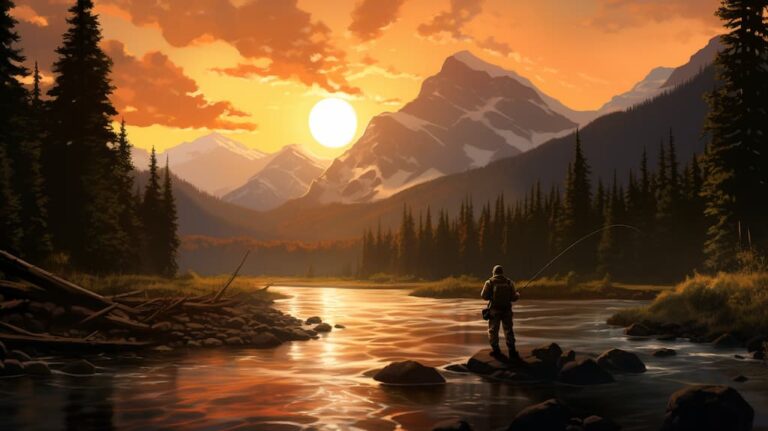
Key Takeaways
- Trout fly fishing is a popular and enjoyable activity for both beginners and advanced anglers.
- Choosing the right flies is crucial for successful trout fishing.
- Mastering various fly fishing techniques will enhance your chances of catching trout.
- Having the appropriate equipment is essential for a successful fishing experience.
- Understanding trout behavior and habitat preferences is vital for targeting them effectively.
The Importance of Proper Fly Selection
One of the key factors in successful trout fly fishing is choosing the right flies. Different trout species and fishing conditions require specific fly patterns and sizes. Understanding the aquatic insect life and matching your flies to their natural prey will greatly increase your chances of enticing a bite. We’ll explore various fly patterns and discuss when and how to use them effectively.
Trout are selective feeders, and their diet primarily consists of insects, baitfish, and crustaceans. To fool these finicky fish, it’s essential to present them with flies that closely resemble their preferred prey. By understanding the behavior and feeding habits of different trout species, you can strategically choose the most effective flies for a successful fishing outing.
When selecting trout flies, it’s important to consider factors such as water temperature, time of year, and the specific body of water you’re fishing in. Different seasons and water conditions dictate the type of insects and other organisms present, influencing trout feeding preferences.
Here are some popular types of trout flies and the situations they excel in:
- Dry Flies: These imitate adult insects that float on the water’s surface. They are ideal for targeting rising trout in calm, slow-moving waters. Dry flies such as the Elk Hair Caddis and Adams are highly effective during hatch periods when you spot trout feeding on the surface.
- Nymphs: Designed to imitate immature aquatic insects, nymphs are fished below the surface to intercept trout feeding near the bottom. Patterns like the Pheasant Tail Nymph and Hare’s Ear are go-to choices for nymphing.
- Streamers: Streamer flies mimic baitfish or larger aquatic insects and are often used to attract aggressive trout. They are fished with a stripping or jerking motion to simulate prey in distress. Examples include the Woolly Bugger and Zonker.
- Wet Flies: Wet flies sink below the surface and imitate emerging insects or dying adults. They are commonly used in rivers and streams. Classic patterns like the Soft Hackle and Partridge and Orange are reliable choices.
Having a diverse selection of trout flies in your tackle box will allow you to adapt to changing fishing conditions and effectively match the trout’s preferred prey. Remember to experiment with different patterns and sizes to find what works best on any given day.
By selecting the right flies and presenting them convincingly, you’ll increase your chances of fooling trout and experiencing the thrill of a successful catch.
Now that you understand the importance of proper fly selection, let’s dive deeper into various trout fishing techniques in the next section.
Mastering Fly Fishing Techniques
To become a skilled trout fly fisherman, it’s important to master a variety of fly fishing techniques. From dry fly fishing to nymphing and streamer fishing, each technique has its own nuances and strategies. We’ll delve into the details of these techniques, providing tips and tricks to help you improve your casting, presentation, and hook-set skills.
Dry Fly Fishing
Dry fly fishing is an exhilarating technique that involves presenting flies that float on the water’s surface, imitating adult insects. It requires precise casting and careful observation of trout feeding behavior. To improve your dry fly fishing experience, try the following tips:
- Select flies that accurately match the size and color of the insects hatching on the water.
- Master the art of delicate casting to avoid spooking the fish.
- Observe the water for rising fish and target your presentations accordingly.
Nymphing
Nymphing is a highly effective technique for targeting trout below the surface. It involves presenting imitative nymph flies that mimic aquatic insects in their various life stages. To enhance your nymphing skills, consider these tips:
- Choose flies that closely resemble the nymphs present in the water.
- Focus on achieving a drag-free drift to imitate the natural movement of nymphs.
- Pay attention to subtle strikes or changes in line tension.
Streamer Fishing
Streamer fishing is an aggressive technique that involves presenting large, imitation baitfish flies to provoke territorial strikes from trout. It’s an effective method for targeting larger trout in both rivers and lakes. Follow these tips to improve your streamer fishing success:
- Vary your retrieve speed to imitate the movement of injured baitfish.
- Experiment with different streamer designs, colors, and sizes to find what works best in different water conditions.
- Target structure, such as submerged logs or undercut banks, where trout are likely to ambush prey.
By mastering these fly fishing techniques, you’ll be able to adapt to different fishing conditions and increase your chances of landing that trophy trout. Remember, practice makes perfect, so get out on the water and hone your skills. Happy fishing!
Essential Trout Fishing Equipment
Having the right equipment is crucial for a successful trout fly fishing experience. Understanding the different types and sizes of gear will enable you to make informed decisions when selecting your equipment. In this section, we’ll discuss the necessary gear for trout fishing, including fly rods, reels, lines, leaders, and tippets.
1. Fly Rods
A well-balanced fly rod is the foundation of your trout fishing setup. When choosing a fly rod, consider the weight, length, and action that best suits your fishing style and the type of water you’ll be fishing in. Lighter weight rods are ideal for small streams and delicate presentations, while heavier rods are better suited for larger rivers and windy conditions. Look for top brands such as Sage, Orvis, and G. Loomis for reliable performance.
2. Reels
A quality reel is essential for efficiently playing and landing trout. Look for a reel that matches the weight and balance of your fly rod. The reel should have a smooth and reliable drag system, allowing you to control the line when fighting a fish. Some popular reel brands among trout anglers include Ross, Hardy, and Abel.
3. Fly Lines
Fly lines come in various types and weights, each designed for specific fishing situations. A weight forward (WF) floating line is a versatile choice for trout fly fishing and is suitable for both beginners and experienced anglers. Consider purchasing additional fly lines with different sinking rates or intermediate lines for varying water depths and conditions. Top fly line manufacturers include Scientific Anglers, Rio, and Airflo.
4. Leaders and Tippets
Leaders and tippets are crucial for presenting your flies with a natural drift and stealthy approach. Leaders are tapered monofilament or fluorocarbon lines that connect the fly line to the tippet. Tippets are thinner sections of line attached to the end of the leader, providing a fine and transparent connection between the fly and the leader. Opt for leaders and tippets with appropriate lengths and breaking strengths, depending on the size of flies and fish you’ll be targeting. Trusted brands like Umpqua, Rio, and Froghair offer reliable leader and tippet options.
| Equipment | Recommended Brands |
|---|---|
| Fly Rods | Sage, Orvis, G. Loomis |
| Reels | Ross, Hardy, Abel |
| Fly Lines | Scientific Anglers, Rio, Airflo |
| Leaders and Tippets | Umpqua, Rio, Froghair |
Investing in high-quality trout fishing equipment will greatly enhance your fishing experience and improve your chances of success on the water. Remember to match your gear to the fishing conditions, target species, and your personal angling preferences.

Choosing the Perfect Fishing Locale
Trout fishing is a diverse and thrilling activity that can be enjoyed in various bodies of water, including rivers, lakes, and streams. Each location offers unique characteristics and challenges for anglers seeking the perfect trout fishing experience. Whether you prefer the peaceful solitude of a serene stream or the vast expanse of a shimmering lake, there is a trout fishing location that suits your preferences.
“The charm of trout fishing lies in its ability to transport you to some of the most picturesque and serene locations on Earth.” -Angler’s Digest
When choosing a fishing locale for trout, it’s essential to consider factors such as seasonality, local regulations, and the types of waters available. Let’s explore some popular trout fishing destinations and dive into the best times to visit, local regulations to keep in mind, and tactics for fishing in different types of waters.
Rivers and Streams
Rivers and streams are often the go-to choice for trout anglers seeking a classic fly fishing experience. These flowing waters provide an ideal habitat for trout, offering ample food sources and shelter. The challenging current and ever-changing conditions make river and stream fishing both mentally and physically stimulating.
Popular trout fishing rivers and streams include:
| Location | Best Time to Visit | Local Regulations | Tactics |
|---|---|---|---|
| Colorado River, Colorado, USA | Spring and early summer for high runoff, late summer and fall for stable flows | Check state fishing regulations for bag limits and special regulations | Focus on pocket water and riffles; use nymphing techniques with attractor patterns |
| River Test, Hampshire, England | Year-round, but prime time is April to October | Check local fishing regulations and obtain necessary permits | Consider dry fly fishing in slower pools and deep runs; match the hatch |
| Tongariro River, North Island, New Zealand | Year-round, but peak season is May to October | Check local fishing regulations and obtain necessary licenses | Swing wet flies or nymphs through the famous pool and riffle sections |
Lakes
Fishing in lakes offers a different trout fishing experience, with open waters and the potential for larger fish. Lakes provide ample opportunities for boat fishing, shore casting, and even ice fishing in colder climates. These serene bodies of water often reward anglers with breathtaking views and a sense of tranquility.
Notable lake fishing destinations for trout include:
| Location | Best Time to Visit | Local Regulations | Tactics |
|---|---|---|---|
| Lake Taupo, North Island, New Zealand | Year-round, with peak season from November to April | Check local fishing regulations and obtain necessary licenses | Troll or cast streamer patterns near submerged structures, and target drop-offs |
| Lake District, Cumbria, England | Year-round, but prime time is spring and autumn | Check local fishing regulations and obtain necessary permits | Focus on shallow bays and weed beds; use both floating and sinking lines |
| Lake Tahoe, California/Nevada, USA | Year-round, but spring and autumn offer optimum conditions | Check state fishing regulations for bag limits and special regulations | Troll deep water with downriggers and target nearshore drop-offs |
By choosing the perfect fishing locale tailored to your preferences, you’ll have the opportunity to immerse yourself in the beauty of nature while pursuing the prized trout. Remember to research local regulations, obtain necessary permits or licenses, and learn about the specific tactics that work best in each location to maximize your chances of a successful and memorable fishing experience.
Tips for Beginners in Trout Fly Fishing
If you’re new to trout fly fishing, we’ve got you covered. We’ll provide valuable tips and advice to help you get started on the right foot. From learning basic casting techniques to understanding trout behavior, these beginner tips will give you the confidence to venture out and experience the thrill of catching your first trout on the fly.
Trout fly fishing is an exciting sport that combines skill, patience, and a deep appreciation for nature. Whether you’re a complete beginner or have some fishing experience, these tips will help you navigate the world of trout fly fishing and increase your chances of success on the water.
Acquaint Yourself with Basic Casting Techniques
Before hitting the water, it’s essential to learn the basics of casting. Mastering your casting technique will improve your accuracy and presentation, increasing your chances of enticing a bite. Focus on developing a smooth and controlled casting motion, using your wrist, forearm, and shoulder to generate power.
Remember, practice makes perfect. Dedicate some time to practice your casting technique before heading out to fish.
Understand Trout Behavior and Habitat
To effectively catch trout, it’s important to understand their behavior and the habitats they inhabit. Trout are primarily found in streams, rivers, and lakes, where they thrive in cold, oxygen-rich waters. They tend to feed on insects, smaller fish, and other aquatic creatures.
Pay attention to the water conditions, such as temperature, clarity, and flow. These factors can significantly influence trout behavior and feeding patterns.
Choose the Right Fly Patterns
The right fly pattern can make all the difference in enticing trout to strike. As a beginner, it’s recommended to start with a few versatile and popular patterns, such as Adams, Elk Hair Caddis, and Woolly Bugger. These flies imitate various insects and can be effective in a wide range of fishing conditions.
Remember to match your fly pattern to the insects present in the water and adjust the size and color accordingly.
| Fly Pattern | Imitates | Fishing Conditions |
|---|---|---|
| Adams | Mayfly | General purpose, versatile |
| Elk Hair Caddis | Caddisfly | Stimulates aggressive strikes, fast water |
| Woolly Bugger | Leach, minnow | Attracts larger trout, still or moving water |
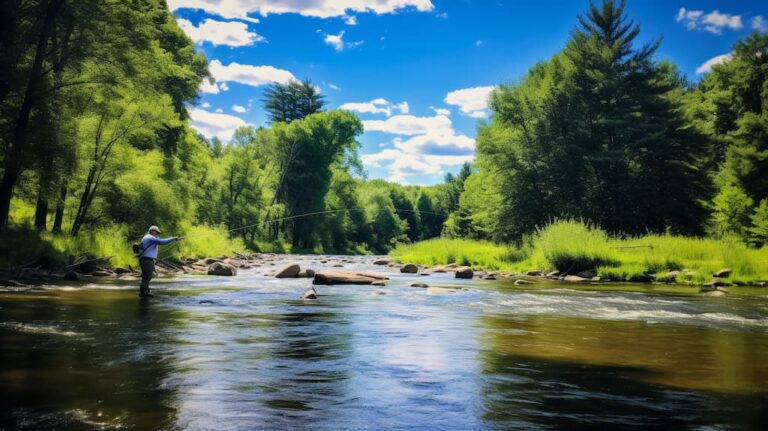
By starting with these fly patterns, you’ll have a good foundation to build upon as you gain more experience and knowledge about trout fly fishing.
Explore Beginner-Friendly Fishing Locations
As a beginner, it’s essential to choose fishing locations that are suitable for your skill level. Look for areas with easy access, clear water, and abundant trout populations. Local fishing shops, online forums, and guidebooks are excellent resources for finding beginner-friendly fishing spots.
Don’t be afraid to seek advice from experienced anglers or hire a fishing guide to show you the ropes and introduce you to productive fishing locations.
Remember, trout fly fishing is a journey of continuous learning and improvement. Take the time to soak in the beauty of the surroundings, connect with nature, and enjoy the experience. With practice, persistence, and these beginner tips, you’ll soon be on your way to becoming a skilled trout fly fisherman.
Advanced Techniques for Seasoned Anglers
For experienced anglers looking to take their trout fly fishing skills to the next level, we’ll explore advanced techniques and strategies. From mastering technical casts to refining your presentation, these tips and tricks will challenge even the most seasoned fly fisherman.
Mastering Technical Casts
Technical casts are essential for targeting trout in challenging fishing situations. By acquiring the skills to execute precise and specialized casts, you can effectively present your fly to difficult-to-reach areas and fool wary trout. Consider practicing the following advanced techniques:
- Roll Cast: Perfect for fishing in tight quarters with limited backcasting space, the roll cast allows you to deliver your fly accurately without the need for a traditional backcast. This technique is particularly useful when fishing under trees or along brushy shorelines.
- Reach Cast: The reach cast allows you to present your fly to trout while minimizing your profile and reducing unnatural drag. By extending the reach of your cast and subtly adjusting the position of your line mid-air, you can achieve a more natural drift and entice wary trout to strike.
- Tuck Cast: When fishing with nymphs or other subsurface patterns, the tuck cast is a valuable technique for achieving a controlled and effective presentation. By using a crisp stop at the end of your forward cast, you can drop the fly and leader quickly onto the water’s surface, imitating the natural motion of nymphs sinking to the bottom.
Refining Your Presentation
Mastering the art of presentation is crucial for fooling selective trout. By paying attention to the following aspects of fly presentation, you can increase your success on the water:
- Drag-free Drift: Achieving a drag-free drift is essential when fishing dry flies or nymphs. By mending your line upstream or utilizing advanced casting techniques to minimize drag, you can create a presentation that mimics the natural drift of insects on the water’s surface or sub-surface.
- Matching the Hatch: In advanced trout fly fishing, accurately matching the specific insect species hatching on the water is vital. Pay close attention to the size, color, and behavior of the insects you observe on the water and select or tie flies that closely resemble them. This attention to detail will greatly increase your chances of success.
Remember, advanced trout fly fishing requires patience, persistence, and a keen eye for detail. Take the time to refine your skills and experiment with different techniques to unlock greater success on the water.
| Advanced Techniques | Benefits |
|---|---|
| Mastering Technical Casts | – Target trout in challenging fishing situations – Deliver your fly accurately in tight quarters – Fool wary trout with specialized casts |
| Refining Your Presentation | – Achieve a drag-free drift – Match the hatch with precision – Fool selective trout with a realistic presentation |
The Art of Fly Tying
Fly tying is not only a practical skill for creating your own customized flies but also a creative art form. It allows you to tailor your flies to match the specific characteristics of the insects trout feed on, increasing your chances of success on the water. Whether you’re a beginner or an experienced fly tyer, this section will provide you with inspiration and guidance to further enhance your fly tying skills.
The process of fly tying involves using a variety of materials, tools, and techniques to construct lifelike imitations of natural insects. By manipulating feathers, fur, and synthetic materials, you can create flies that mimic the appearance and behavior of the insects trout actively seek out. This level of customization allows you to experiment and find the patterns that work best in different fishing conditions and locations.
To get started with fly tying, you’ll need a few essential tools and materials. Here are some of the key items you’ll need:
- Vises – a device that holds the hook securely while you tie the fly
- Scissors – for cutting materials to size
- Bobbin – used to hold and control the thread while tying
- Hooks – the foundation of your fly, available in various sizes and styles
- Thread – used to secure materials to the hook
- Feathers, fur, and synthetics – these materials provide the natural appearance and movement of the fly
As you progress in your fly tying journey, you can expand your toolkit with additional specialized tools such as hackle pliers, whip finishers, and dubbing brushes to further refine your creations.
There are various fly tying techniques you can employ, depending on the specific patterns you’re tying. These techniques include wrapping, stacking, palmering, and spinning materials onto the hook. Each technique contributes to the overall shape, profile, and movement of the fly, allowing you to replicate the insects trout are actively feeding on.
The beauty of fly tying lies in the infinite possibilities for creativity and self-expression. It offers anglers the opportunity to not only catch more fish but also unleash their artistic side, crafting unique and effective patterns that can’t be found in fishing stores. Whether you’re tying classic patterns or experimenting with your own creations, the art of fly tying opens up a world of endless possibilities.
Remember, practice makes perfect when it comes to fly tying. Take the time to experiment with different materials, colors, and techniques to find what works best for you. Don’t be afraid to seek inspiration from fellow fly tyers, books, or online resources. With patience and persistence, you’ll soon discover the joy of creating flies that fool even the most selective trout.
| Benefits of Fly Tying | Challenges of Fly Tying |
|---|---|
| Customization: Tailor your flies to match specific insect patterns, sizes, and colors.Savings: Avoid the need to purchase expensive flies.Experimentation: Create unique patterns that are not commercially available.Self-Sufficiency: Develop the skills to tie flies wherever and whenever you need them. | Learning Curve: It takes time and practice to master fly tying techniques.Material Selection: Choosing the right materials can be overwhelming for beginners.Patience: Tying intricate patterns requires attention to detail and perseverance.Tool Investment: Acquiring the necessary tools can be expensive initially. |
Understanding Trout Behavior
To effectively target trout, it’s crucial to understand their behavior patterns and habitat preferences. By gaining insights into how trout behave, you can make informed decisions that will greatly enhance your chances of success on the water.
Feeding Habits
t are opportunistic feeders, and their diet consists primarily of aquatic insects, crustaceans, and small fish. Understanding their feeding habits is key to presenting the right flies and increasing your chances of a strike. Trout often seek out areas of current where food is most abundant, such as riffles and seams. They also tend to feed more actively in low-light conditions, such as early mornings and late evenings.
The Impact of Weather Conditions
Weather conditions greatly influence trout behavior. A mild overcast day with a light drizzle can stimulate trout activity, while bright sunlight and high temperatures tend to make them more wary and less likely to feed actively. By paying attention to weather patterns and adjusting your fishing strategies accordingly, you can maximize your chances of encountering feeding trout.
Influence of Water Temperature and Clarity
Water temperature and clarity are crucial factors that affect trout behavior. Trout are cold-water species and thrive in temperatures between 50 and 60 degrees Fahrenheit. During warmer months, they may seek colder, oxygen-rich water, such as deep pools and shaded areas. In terms of water clarity, trout tend to be more cautious in clear water and are less likely to take obvious or unnatural-looking flies. In such conditions, using smaller and more realistic patterns can yield better results.
“Understanding trout behavior is like unlocking a secret code that leads to successful fishing. By observing their feeding habits, adapting to weather conditions, and making informed decisions based on water temperature and clarity, you’ll be on your way to becoming a more accomplished trout angler.”
Safety and Conservation in Trout Fly Fishing
As responsible anglers, you have a duty to protect and preserve our waterways and trout populations. By practicing good conservation principles, we can ensure the sustainability of trout fly fishing for future generations. In this section, we’ll address important topics such as catch and release practices, ethical fishing behavior, and ways to minimize our impact on the environment.
Catch and Release Practices
When practicing catch and release, it’s essential to handle the fish with care to minimize stress and maximize their chance of survival. Here are some tips to follow:
- Use barbless hooks or flatten the barb to facilitate easy hook removal.
- Handle the fish gently with wet hands to protect their protective slime coat.
- Minimize air exposure by keeping the fish in the water as much as possible.
- Revive the fish by holding it upright in a gentle current and allowing it to regain its strength before releasing.
Ethical Fishing Behavior
As stewards of the environment, it’s important to practice ethical fishing behavior. Here are some guidelines to follow:
- Respect fishing regulations and size limits to ensure the sustainability of fish populations.
- Do not litter and always dispose of fishing lines, hooks, and other waste properly.
- Respect other anglers by giving them space and observing proper etiquette on the water.
- Be mindful of noise pollution and avoid excessive noise that could disturb wildlife or other anglers.
Minimizing Environmental Impact
To minimize our impact on the environment while trout fly fishing, consider the following tips:
- Stay on designated trails and avoid trampling on sensitive vegetation.
- Do not disturb spawning grounds or redds, and avoid fishing in areas where fish are actively spawning.
- Practice proper waste management and pack out all trash, including non-biodegradable items.
- Use environmentally-friendly fishing gear and tackle, such as lead-free weights and biodegradable fishing lines.
By following these practices and principles of conservation, we can ensure that trout populations thrive and that future generations can enjoy the beauty and excitement of trout fly fishing.
Remember, the future of trout fly fishing lies in our hands. Let’s protect and preserve these precious resources for generations to come.
Conclusion
Trout fly fishing offers a fulfilling and exhilarating experience for anglers of all skill levels. With the knowledge and techniques shared in this guide, you’ll be equipped to handle any trout fishing situation. Remember to show respect for the fish, the environment, and your fellow anglers as you embark on your trout fly fishing adventures. By employing the principles of conservation and practicing ethical fishing, we can ensure the preservation of these magnificent fish for generations to come.
So, get out there and enjoy the thrill of hooking and landing trout on the fly! Whether you’re a beginner or an experienced angler, the tranquility of the water and the anticipation of the tug on your line will keep you coming back for more. May your days be filled with tight lines and fond memories of the trout you’ve caught.


